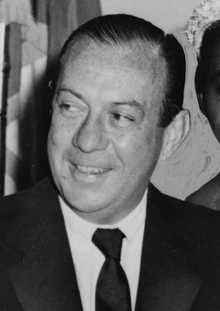United States presidential election, 1956
| | |||||||||||||||||||||||||||||||||||||||||||
| |||||||||||||||||||||||||||||||||||||||||||
| |||||||||||||||||||||||||||||||||||||||||||
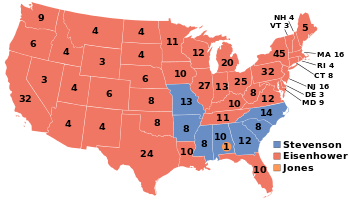
 | |||||||||||||||||||||||||||||||||||||||||||
| Presidential election results map. Red denotes states won by Eisenhower/Nixon, blue denotes those won by Stevenson/Kefauver, orange is the electoral vote for Walter Burgwyn Jones by an Alabama faithless elector. Numbers indicate the number of electoral votes allotted to each state. | |||||||||||||||||||||||||||||||||||||||||||
| |||||||||||||||||||||||||||||||||||||||||||
The United States presidential election of 1956 was the 43rd quadrennial presidential election, held on Tuesday, November 6, 1956. The popular incumbent President, Republican Dwight D. Eisenhower, successfully ran for re-election. The election was a re-match of 1952, as Eisenhower's opponent in 1956 was Adlai Stevenson, a former Illinois governor, whom Eisenhower had defeated four years earlier.
Eisenhower was popular, although his health had become a quiet issue.[3] Stevenson remained popular with a core of liberal Democrats, but held no office and had no real base. He (and Eisenhower) largely ignored the subject of civil rights. As the country enjoyed peace - Eisenhower had ended the Korean War - and economic growth, few doubted a successful re-election for the charismatic Eisenhower.
Compared to the 1952 election, Eisenhower gained Kentucky, Louisiana, and West Virginia from Stevenson, while losing Missouri.
This was the last presidential election before the admissions of Alaska and Hawaii, which would participate for the first time as states in the 1960 presidential election. It was also the last election in which any of the major candidates was born in the 19th century, and it is the latest where both candidates were renominated for a rematch of the previous presidential election.
Nominations
Republican Party
Republican candidates
- Dwight D. Eisenhower, President of the United States[4]
Early in 1956, there was speculation that President Eisenhower would not run for a second term because of concerns about his health. In 1955, Eisenhower had suffered a serious heart attack, and in early 1956 he underwent surgery for ileitis. However, he quickly recovered after both incidents, and after being cleared by his doctors, he decided to run for a second term. Given Eisenhower's enormous popularity, he was re-nominated with no opposition at the 1956 Republican National Convention in San Francisco, California.
The only question among Republicans was whether Vice-President Richard Nixon would again be Eisenhower's running mate. There is some evidence that Eisenhower would have preferred a less controversial running mate, such as Governor Christian Herter of Massachusetts, and according to some historians (such as Stephen E. Ambrose), Eisenhower privately offered Nixon another position in his cabinet, such as Secretary of Defense. However, Harold Stassen was the only Republican to publicly oppose Nixon's re-nomination for Vice-President, and Nixon remained highly popular among the Republican rank-and-file voters. Nixon had also reshaped the vice-presidency, using it as a platform to campaign for Republican state and local candidates across the country, and these candidates came to his defense. In the spring of 1956, Eisenhower publicly announced that Nixon would again be his running mate, and Stassen was forced to second Nixon's nomination at the Republican Convention. Unlike 1952, conservative Republicans (who had supported Robert A. Taft against Eisenhower in 1952) did not attempt to shape the platform. At the convention, one delegate voted for a fictitious "Joe Smith" for Vice-President to prevent a unanimous vote.
Democratic Party
Democratic candidates
- Adlai Stevenson, former governor of Illinois
- Estes Kefauver, U.S. senator from Tennessee
- W. Averell Harriman, governor of New York
Candidates gallery
-
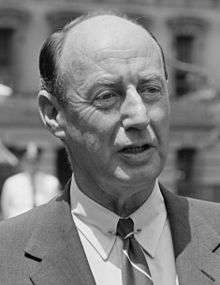
Former Governor Adlai Stevenson of Illinois
Primaries
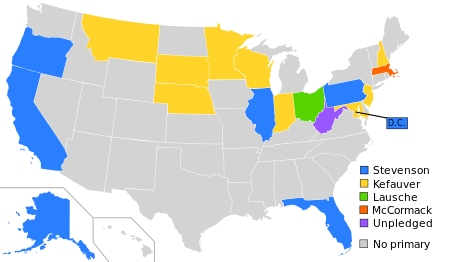
Adlai Stevenson, the Democratic Party's 1952 nominee, fought a tight primary battle with populist Tennessee Senator Estes Kefauver for the 1956 nomination. Kefauver won the New Hampshire primary unopposed (though Stevenson won 15% on write-ins). After Kefauver upset Stevenson in the Minnesota primary, Stevenson, realizing that he was in trouble, agreed to debate Kefauver in Florida. Stevenson and Kefauver held the first televised presidential debate on May 21, 1956, before the Florida primary. Stevenson carried Florida by a 52-48% margin. By the time of the California primary in June 1956, Kefauver's campaign had run low on money and could not compete for publicity and advertising with the well-funded Stevenson. Stevenson won the California primary by a 63-37% margin, and Kefauver soon withdrew from the race.
Popular vote results
- Adlai Stevenson - 3,069,504 (50.70%)
- Estes Kefauver - 2,283,172 (37.71%)
- Unpledged - 380,300 (6.28%)
- Frank Lausche - 278,074 (4.59%)
- John William McCormack - 26,128 (0.43%)
Elvis Presley had 5,000 write-in votes
Democratic National Convention
At the 1956 Democratic National Convention in Chicago, Illinois, New York Governor W. Averell Harriman, who was backed by former President Harry S. Truman, challenged Stevenson for the nomination. However, Stevenson's delegate lead was much too large for Harriman to overcome, and Stevenson won the nomination on the first ballot.
The roll call, as reported in Richard C. Bain and Judith H. Parris, Convention Decisions and Voting Records, pp. 294–298:
| Presidential Balloting, DNC 1956 | |
|---|---|
| Contender | Vote |
| Adlai Stevenson | 905.5 |
| W. Averell Harriman | 210 |
| Lyndon B. Johnson | 80 |
| Stuart Symington | 45.5 |
| Happy Chandler | 36.5 |
| James C. Davis | 33 |
| John S. Battle | 32.5 |
| George Bell Timmerman, Jr. | 23.5 |
| Frank Lausche | 5.5 |
Vice-Presidential Nomination
-

Senator John F. Kennedy from Massachusetts
-

Senator Albert Gore, Sr. from Tennessee
-
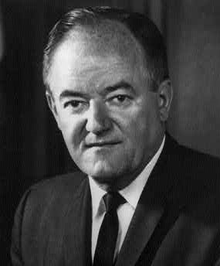
Senator Hubert Humphrey from Minnesota
The highlight of the 1956 Democratic Convention came when Stevenson, to create excitement for the ticket, made the surprise announcement that the convention's delegates would choose his running mate. This set off a desperate scramble among several candidates to win the nomination. Potential vice-presidential candidates had only one hectic day to campaign among the delegates before the voting began. The two leading contenders were Senator Kefauver, who retained the support of his primary delegates, and young Senator John F. Kennedy from Massachusetts, who was relatively unknown at that point. Although Stevenson privately preferred Senator Kennedy to be his running mate, he did not attempt to influence the balloting for Kennedy in any way. Kennedy surprised the experts by surging into the lead on the second ballot; at one point, he was only 15 votes shy of winning. However, a number of states then left their "favorite son" candidates and switched to Kefauver, giving him the victory. Kennedy then gave a gracious concession speech. The defeat was a boost for Kennedy's long-term presidential chances: as a serious contender, he gained favorable national publicity, yet by losing to Kefauver he avoided blame for Stevenson's loss to Eisenhower in November. The vote totals in the vice-presidential balloting are recorded in the following table, which also comes from Bain & Parris.
| Vice Presidential Balloting, DNC 1956 | |||
|---|---|---|---|
| Ballot | 1 | 2 before shifts | 2 after shifts |
| Estes Kefauver | 466.5 | 551.5 | 755.5 |
| John F. Kennedy | 294.5 | 618 | 589 |
| Albert Gore, Sr. | 178 | 110.5 | 13.5 |
| Robert F. Wagner, Jr. | 162.5 | 9.5 | 6 |
| Hubert Humphrey | 134 | 74.5 | 2 |
| Luther H. Hodges | 40 | 0.5 | 0 |
| P.T. Maner | 33 | 0 | 0 |
| LeRoy Collins | 29 | 0 | 0 |
| Clinton Presba Anderson | 16 | 0 | 0 |
| Frank G. Clement | 14 | 0 | 0 |
| Pat Brown | 1 | 0 | 0 |
| Lyndon B. Johnson | 1 | 0 | 0 |
| Stuart Symington | 1 | 0 | 0 |
General election
Campaign
Stevenson campaigned hard against Eisenhower, with television ads for the first time being the dominant medium for both sides. Because Eisenhower's 1952 election victory was due, in large part, to winning the female vote, there was a plethora of "housewife" focused ads. Some commentators at the time also argued that television's new prominence was a major factor in Eisenhower's decision to run for a second term at age 66, considering his weak health after the heart attack in 1955. Television allowed Eisenhower to reach people across the country without enduring the strain of repeated coast-to-coast travel, making a national campaign more feasible.[5]
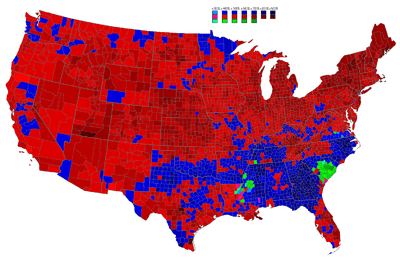
Stevenson proposed significant increases in government spending for social programs and treaties with the Soviet Union to lower military spending and end nuclear testing on both sides. He also proposed to end the military draft and switch to an "all-volunteer" military. Eisenhower publicly opposed these ideas, even though in private he was working on a proposal to ban atmospheric nuclear testing. Eisenhower had retained the enormous personal and political popularity he had earned during World War II, and he maintained a comfortable lead in the polls throughout the campaign.
Eisenhower was also helped by his handling of two developing foreign-policy crises that occurred in the weeks before the election. In the Soviet-occupied People's Republic of Hungary, many citizens had risen in revolt in the Revolution of 1956 against Soviet domination, but the Soviets responded by invading the country on October 26. Three days later, a combined force of Israeli, British, and French troops invaded Egypt to topple Gamal Abdel Nasser and seize the recently nationalized Suez Canal. The resolution of the latter crisis rapidly moved to the United Nations,[6] and the Hungarian revolt was brutally crushed within a few days by re-deployed Soviet troops. Eisenhower condemned both actions, but was unable to help Hungary; he did, however, forcefully pressure the western forces to withdraw from Egypt.
While these two events led many Americans to rally in support of the president and swelled his expected margin of victory, the campaign was seen differently by some foreign governments.[7] The Eisenhower administration had also supported the Brown v. Board of Education ruling in 1954; this ruling by the U.S. Supreme Court ended legal segregation in public schools. As a result, Eisenhower won the support of nearly 40% of black voters; he was the last Republican presidential candidate to receive such a level of support from black voters.
Eisenhower led all opinion polls by large margins throughout the campaign. On Election Day Eisenhower took over 57% of the popular vote and won 41 of the 48 states. Stevenson won only six Southern states and the border state of Missouri, becoming the first losing candidate since William Jennings Bryan in 1900 to carry Missouri. Eisenhower carried Louisiana, making him the first Republican presidential candidate to carry the state since Rutherford Hayes had done so in 1876 during Reconstruction.
Results
| Presidential candidate | Party | Home state | Popular vote | Electoral vote |
Running mate | |||
|---|---|---|---|---|---|---|---|---|
| Count | Pct | Vice-presidential candidate | Home state | Elect. vote | ||||
| Dwight D. Eisenhower (Incumbent) | Republican | Pennsylvania | 35,579,180 | 57.37% | 457 | Richard Nixon | California | 457 |
| Adlai Stevenson | Democratic | Illinois | 26,028,028 | 41.97% | 73 | Estes Kefauver | Tennessee | 73 |
| (Unpledged electors) | (n/a) | (n/a) | 196,145 | 0.32% | 0 | (n/a) | (n/a) | 0 |
| T. Coleman Andrews | States' Rights | Virginia | 107,929 | 0.17% | 0 | Thomas Werdel | California | 0 |
| Eric Hass | Socialist Labor | New York | 44,300 | 0.07% | 0 | Georgia Cozzini | Wisconsin | 0 |
| Enoch A. Holtwick | Prohibition | Illinois | 41,937 | 0.07% | 0 | Edwin M. Cooper | California | 0 |
| Walter Burgwyn Jones | Democratic | Alabama | —(a) | —(a) | 1 | Herman Talmadge | Georgia | 1 |
| Other | 23,809 | 0.04% | — | Other | — | |||
| Total | 62,021,328 | 100% | 531 | 531 | ||||
| Needed to win | 266 | 266 | ||||||
Source (Popular Vote): Leip, David. "1956 Presidential Election Results". Dave Leip's Atlas of U.S. Presidential Elections. Retrieved August 1, 2005.Source (Electoral Vote): "Electoral College Box Scores 1789–1996". National Archives and Records Administration. Retrieved August 1, 2005.

-

Results by county, shaded according to winning candidate's percentage of the vote
Results by state
| States won by Eisenhower/Nixon |
| States won by Stevenson/Kefauver |
| Dwight D. Eisenhower Republican |
Adlai Stevenson Democratic |
T. Coleman Andrews/ Unpledged Electors States' Rights |
Eric Hass Socialist Labor |
Margin | State Total | ||||||||||||
|---|---|---|---|---|---|---|---|---|---|---|---|---|---|---|---|---|---|
| State | electoral votes |
# | % | electoral votes |
# | % | electoral votes |
# | % | electoral votes |
# | % | electoral votes |
# | % | # | |
| Alabama | 11 | 195,694 | 39.40 | - | 280,844 | 56.54 | 10 | 20,150 | 4.06 | - | - | - | - | -85,150 | -17.14 | 496,698 | AL |
| Arizona | 4 | 176,990 | 60.99 | 4 | 112,880 | 38.90 | - | 303 | 0.10 | - | - | - | - | 64,110 | 22.09 | 290,173 | AZ |
| Arkansas | 8 | 186,287 | 45.82 | - | 213,277 | 52.46 | 8 | 7,008 | 1.72 | - | - | - | - | -26,990 | -6.64 | 406,572 | AR |
| California | 32 | 3,027,668 | 55.39 | 32 | 2,420,135 | 44.27 | - | 6,087 | 0.11 | - | 300 | 0.01 | - | 607,533 | 11.11 | 5,466,355 | CA |
| Colorado | 6 | 394,479 | 59.49 | 6 | 263,997 | 39.81 | - | 759 | 0.11 | - | 3,308 | 0.50 | - | 130,482 | 19.68 | 663,074 | CO |
| Connecticut | 8 | 711,837 | 63.72 | 8 | 405,079 | 36.26 | - | - | - | - | - | - | - | 306,758 | 27.46 | 1,117,121 | CT |
| Delaware | 3 | 98,057 | 55.09 | 3 | 79,421 | 44.62 | - | - | - | - | 110 | 0.06 | - | 18,636 | 10.47 | 177,988 | DE |
| Florida | 10 | 643,849 | 57.27 | 10 | 480,371 | 42.73 | - | - | - | - | - | - | - | 163,478 | 14.54 | 1,124,220 | FL |
| Georgia | 12 | 216,652 | 32.65 | - | 441,094 | 66.48 | 12 | - | - | - | - | - | - | -224,442 | -33.83 | 663,480 | GA |
| Idaho | 4 | 166,979 | 61.17 | 4 | 105,868 | 38.78 | - | - | - | - | - | - | - | 61,111 | 22.39 | 272,989 | ID |
| Illinois | 27 | 2,623,327 | 59.52 | 27 | 1,775,682 | 40.29 | - | - | - | - | 8,342 | 0.19 | - | 847,645 | 19.23 | 4,407,407 | IL |
| Indiana | 13 | 1,182,811 | 59.90 | 13 | 783,908 | 39.70 | - | - | - | - | 1,334 | 0.07 | - | 398,903 | 20.20 | 1,974,607 | IN |
| Iowa | 10 | 729,187 | 59.06 | 10 | 501,858 | 40.65 | - | 3,202 | 0.26 | - | 125 | 0.01 | - | 227,329 | 18.41 | 1,234,564 | IA |
| Kansas | 8 | 566,878 | 65.44 | 8 | 296,317 | 34.21 | - | - | - | - | - | - | - | 270,561 | 31.23 | 866,243 | KS |
| Kentucky | 10 | 572,192 | 54.30 | 10 | 476,453 | 45.21 | - | 2,657 | 0.25 | - | 358 | 0.03 | - | 95,739 | 9.09 | 1,053,805 | KY |
| Louisiana | 10 | 329,047 | 53.28 | 10 | 243,977 | 39.51 | - | 44,520 | 7.21 | - | - | - | - | 85,070 | 13.78 | 617,544 | LA |
| Maine | 5 | 249,238 | 70.87 | 5 | 102,468 | 29.13 | - | - | - | - | - | - | - | 146,770 | 41.73 | 351,706 | ME |
| Maryland | 9 | 559,738 | 60.04 | 9 | 372,613 | 39.96 | - | - | - | - | - | - | - | 187,125 | 20.07 | 932,351 | MD |
| Massachusetts | 16 | 1,393,197 | 59.32 | 16 | 948,190 | 40.37 | - | - | - | - | 5,573 | 0.24 | - | 445,007 | 18.95 | 2,348,506 | MA |
| Michigan | 20 | 1,713,647 | 55.63 | 20 | 1,359,898 | 44.15 | - | - | - | - | - | - | - | 353,749 | 11.48 | 3,080,468 | MI |
| Minnesota | 11 | 719,302 | 53.68 | 11 | 617,525 | 46.08 | - | - | - | - | 2,080 | 0.16 | - | 101,777 | 7.60 | 1,340,005 | MN |
| Mississippi | 8 | 60,685 | 24.46 | - | 144,498 | 58.23 | 8 | 42,966 | 17.31 | - | - | - | - | -83,813 | -33.78 | 248,149 | MS |
| Missouri | 13 | 914,289 | 49.89 | - | 918,273 | 50.11 | 13 | - | - | - | - | - | - | -3,984 | -0.22 | 1,832,562 | MO |
| Montana | 4 | 154,933 | 57.13 | 4 | 116,238 | 42.87 | - | - | - | - | - | - | - | 38,695 | 14.27 | 271,171 | MT |
| Nebraska | 6 | 378,108 | 65.51 | 6 | 199,029 | 34.49 | - | - | - | - | - | - | - | 179,079 | 31.03 | 577,137 | NE |
| Nevada | 3 | 56,049 | 57.97 | 3 | 40,640 | 42.03 | - | - | - | - | - | - | - | 15,409 | 15.94 | 96,689 | NV |
| New Hampshire | 4 | 176,519 | 66.11 | 4 | 90,364 | 33.84 | - | 111 | 0.04 | - | - | - | - | 86,155 | 32.27 | 266,994 | NH |
| New Jersey | 16 | 1,606,942 | 64.68 | 16 | 850,337 | 34.23 | - | 5,317 | 0.21 | - | 6,736 | 0.27 | - | 756,605 | 30.46 | 2,484,312 | NJ |
| New Mexico | 4 | 146,788 | 57.81 | 4 | 106,098 | 41.78 | - | 364 | 0.14 | - | 69 | 0.03 | - | 40,690 | 16.02 | 253,926 | NM |
| New York | 45 | 4,340,340 | 61.19 | 45 | 2,750,769 | 38.78 | - | - | - | - | - | - | - | 1,589,571 | 22.41 | 7,092,860 | NY |
| North Carolina | 14 | 575,062 | 49.34 | - | 590,530 | 50.66 | 14 | - | - | - | - | - | - | -15,468 | -1.33 | 1,165,592 | NC |
| North Dakota | 4 | 156,766 | 61.72 | 4 | 96,742 | 38.09 | - | 483 | 0.19 | - | - | - | - | 60,024 | 23.63 | 253,991 | ND |
| Ohio | 25 | 2,262,610 | 61.11 | 25 | 1,439,655 | 38.89 | - | - | - | - | - | - | - | 822,955 | 22.23 | 3,702,265 | OH |
| Oklahoma | 8 | 473,769 | 55.13 | 8 | 385,581 | 44.87 | - | - | - | - | - | - | - | 88,188 | 10.26 | 859,350 | OK |
| Oregon | 6 | 406,393 | 55.25 | 6 | 329,204 | 44.75 | - | - | - | - | - | - | - | 77,189 | 10.49 | 735,597 | OR |
| Pennsylvania | 32 | 2,585,252 | 56.49 | 32 | 1,981,769 | 43.30 | - | - | - | - | 7,447 | 0.16 | - | 603,483 | 13.19 | 4,576,503 | PA |
| Rhode Island | 4 | 225,819 | 58.26 | 4 | 161,790 | 41.74 | - | - | - | - | - | - | - | 64,029 | 16.52 | 387,609 | RI |
| South Carolina | 8 | 75,700 | 25.18 | - | 136,372 | 45.37 | 8 | 88,511 | 29.45 | - | - | - | - | -47,863 | -15.92 | 300,583 | SC |
| South Dakota | 4 | 171,569 | 58.39 | 4 | 122,288 | 41.61 | - | - | - | - | - | - | - | 49,281 | 16.77 | 293,857 | SD |
| Tennessee | 11 | 462,288 | 49.21 | 11 | 456,507 | 48.60 | - | 19,820 | 2.11 | - | - | - | - | 5,781 | 0.62 | 939,404 | TN |
| Texas | 24 | 1,080,619 | 55.26 | 24 | 859,958 | 43.98 | - | 14,591 | 0.75 | - | - | - | - | 220,661 | 11.28 | 1,955,545 | TX |
| Utah | 4 | 215,631 | 64.56 | 4 | 118,364 | 35.44 | - | - | - | - | - | - | - | 97,267 | 29.12 | 333,995 | UT |
| Vermont | 3 | 110,390 | 72.16 | 3 | 42,549 | 27.81 | - | - | - | - | - | - | - | 67,841 | 44.35 | 152,978 | VT |
| Virginia | 12 | 386,459 | 55.37 | 12 | 267,760 | 38.36 | - | 42,964 | 6.16 | - | 351 | 0.05 | - | 118,699 | 17.01 | 697,978 | VA |
| Washington | 9 | 620,430 | 53.91 | 9 | 523,002 | 45.44 | - | - | - | - | 7,457 | 0.65 | - | 97,428 | 8.47 | 1,150,889 | WA |
| West Virginia | 8 | 449,297 | 54.08 | 8 | 381,534 | 45.92 | - | - | - | - | - | - | - | 67,763 | 8.16 | 830,831 | WV |
| Wisconsin | 12 | 954,844 | 61.58 | 12 | 586,768 | 37.84 | - | 6,918 | 0.45 | - | 710 | 0.05 | - | 368,076 | 23.74 | 1,550,558 | WI |
| Wyoming | 3 | 74,573 | 60.08 | 3 | 49,554 | 39.92 | - | - | - | - | - | - | - | 25,019 | 20.16 | 124,127 | WY |
| TOTALS: | 531 | 35,579,180 | 57.37 | 457 | 26,028,028 | 41.97 | 73 | 304,074 | 0.49 | - | 44,300 | 0.07 | - | 9,551,152 | 15.40 | 62,021,328 | US |
Close states (margin of victory less than 5%, totaling 38 electoral votes)
- Missouri, 0.22%
- Tennessee, 0.62%
- North Carolina, 1.33%
Close states (margin of victory more than 5%, but less than 10%, totaling 46 electoral votes)
- Arkansas, 6.64%
- Minnesota, 7.60%
- West Virginia, 8.16%
- Washington, 8.47%
- Kentucky, 9.09%
(a) Alabama faithless elector W. F. Turner, who was pledged to Adlai Stevenson and Estes Kefauver, instead cast his votes for Walter Burgwyn Jones, who was a circuit court judge in Turner's home town, and Herman Talmadge, governor of the neighboring state of Georgia.
Because of the admission of Alaska and Hawaii as states in 1959, the 1956 presidential election was the last in which there were 531 electoral votes.
Electoral eccentricities
- The 1956 election was the last time in which the election was a rematch of the election held four years earlier. (Rematches also occurred in 1800, 1828, 1840, 1892, and 1900. It would not be until 1996 when two major candidates would face each other twice, with Democrat Bill Clinton facing third-party candidate Ross Perot.
- The 1956 Democratic vice presidential vote was the last time any convention voting went to a second ballot.
- Missouri was often considered to be a 'bellwether' state because it voted for the winner of nearly every Presidential election in the 100 years between 1904 and 2004. 1956 is the only exception, as it voted for Stevenson despite Eisenhower's convincing nationwide victory (albeit by only 3,984 votes out of more than 1.8 million cast; most of this margin being provided by the City of St. Louis). After 1956, the state reverted to 'bellwether' status and voted for the presidential winner in every election until 2008 and 2012, when it voted for losing Republican candidates over a victorious Barack Obama.
- Eisenhower came in third in South Carolina, behind Stevenson and "unpledged electors", the first incumbent to have this status since William Howard Taft in 1912. This next happened to George Bush in 1992 when he finished third place in Maine behind Bill Clinton and Ross Perot.
- With this election, Eisenhower became the first Republican to carry these states twice in Presidential elections: Arizona, Florida, Idaho, Montana, New Mexico, Oklahoma, Tennessee, Texas, and Virginia.
- Eisenhower was the last Republican until Ronald Reagan in 1984 to win every Northeastern state.
- As of 2012, the 1956 election was the last time the Republican candidate carried all six of the following states in the same election: Maryland, Massachusetts, Minnesota, New York, Pennsylvania and Rhode Island, all of which have since become solid blue states in elections. Since 1956, the only Republican victories in either of these states have been in 1972 (Richard Nixon won all except Massachusetts), 1980 (Ronald Reagan won Massachusetts, New York and Pennsylvania), 1984 (Reagan won all except Minnesota), 1988 (George H. W. Bush won Maryland and Pennsylvania), and 2016 (Donald Trump won Pennsylvania).
- This is one of the last elections where the Democrats had their post Civil War dominance of the Deep South, all of which states have become solid red states in the present day.
See also
- U.S. Senate election, 1956
- History of the United States (1945-1964)
- Second inauguration of Dwight D. Eisenhower
Notes
- ↑ "Voter Turnout in Presidential Elections". The American Presidency Project. UC Santa Barbara.
- ↑ Smith, Jean Edward. Eisenhower In War And Peace, Random House, New York, NY, 2013. p. 703
- ↑ "President Dwight Eisenhower : Health & Medical History". www.doctorzebra.com. Retrieved 2016-05-22.
- ↑ Smith, Jean Edward. Eisenhower In War And Peace, Random House, New York, NY, 2013. p. 703Gettysburg, Pennsylvania.
- ↑ Emmet John Hughes, "52,000,000 TV Sets-How Many Votes?" The New York Times, September 25, 1960, SM23
- ↑ Borhi, László (1999). "Containment, Rollback, Liberation or Inaction? The United States and Hungary in the 1950s" (PDF). Journal of Cold War Studies. 1 (3): 67–108. doi:10.1162/152039799316976814. Retrieved June 29, 2009. As Vice President Richard Nixon later explained: "We couldn't on one hand, complain about the Soviets intervening in Hungary and, on the other hand, approve of the British and the French picking that particular time to intervene against [Gamel Abdel] Nasser".
- ↑ "How Britain France and Israel Got Together". Time. November 12, 1956.
State Department officials are sure that the British and French callously deceived or misled them from this date onward. On October 23 Pineau dashed over to London, reportedly to tell Eden that Israel was all ready to launch preventive war on Nasser. Ben-Gurion's moment was well chosen because, it was reasoned, 1) the U.S. would not dare move decisively against Israel on the verge of a presidential election, and 2) the Hungarian rebellion, then at its height, would keep Russia's hands tied.
- ↑ "1956 Presidential General Election Data - National". Retrieved March 18, 2013.
References
- Leip, Dave. "1956 Presidential Election - Home States". Dave Leip's Atlas of U.S. Presidential Elections. Retrieved May 24, 2005.
- "Electoral Votes for President and Vice President 1953–1965". U.S. Electoral College. National Archives. Retrieved March 18, 2006.
- Campaign commercials from the 1956 election
- Senate Manual, 107th Congress. United States Government Printing Office. 2001. p. 1131. Retrieved March 18, 2006.
- "General Election Returns: November 6, 1956". Maryland Manual. 167: 325. 1957–58.
- "Republican Party National Convention. (26th : 1956 : San Francisco)". Library of Congress Online Catalog. Library of Congress. Retrieved February 28, 2007.
Further reading
- Converse, Philip E., Warren E. Miller, Donald E. Stokes, Angus Campbell. The American Voter (1964) the classic political science study of voters in 1952 and 1956
- Divine, Robert A. (1974). Foreign Policy and U.S. Presidential Elections, 1952–1960. ISBN 0-531-06496-4.
- Gallup, George H., ed. (1972). The Gallup Poll: Public Opinion, 1935–1971. 3 vols. Random House. ISBN 0-394-47270-5. vol 2
External links
- The Election Wall's 1956 Election Video Page
- 1956 popular vote by counties
- The Living Room Candidate: Presidential Campaign Commercials: 1952 – 2004
- How close was the 1956 election? — Michael Sheppard, Massachusetts Institute of Technology
- Eisenhower's 1956 presidential campaign, Dwight D. Eisenhower Presidential Library
- A film clip It's Ike and Nixon! 1956/08/23 (1956)" is available at the Internet Archive
- A film clip Landslide for Eisenhower, 1956/11/08 (1956)" is available at the Internet Archive
- A film clip Eisenhower Re-Elected, 1956/11/05 (1956)" is available at the Internet Archive
- Election of 1956 in Counting the Votes
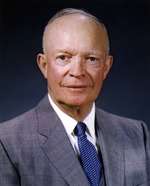
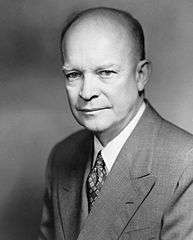
.jpg)

